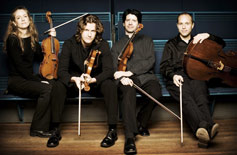

Monday - March 19, 2007
SLAC Today is
available online at:
http://today.slac.stanford.edu
In this issue:
Ensemble to Play Midday Melodies
Dorfan Today: Physics at its Best
Property Control Updates List of Sensitive Items
FKB Celebrates One Year Anniversary
Safety Firsts
 |
 |
|
Monday - March 19, 2007 |
Ensemble to Play Midday Melodies
The St. Lawrence String Quartet
Please join your fellow music lovers this Thursday as the world-class St. Lawrence String Quartet, Stanford's Ensemble-in-Residence, treats SLAC employees to a musical workday interlude. SLAC's own violinist, Sidney Drell, will introduce the group, which will perform pieces they played while recently on tour in Europe: the Haydn Op. 54 No. 2 and the Franck String Quartet. The ensemble, featured in The New Yorker's "Best of 2006" list, has received worldwide acclaim for delivering what BBC Music Magazine describes as "faultless, instantly compelling performances." The show will take place from 12 to 1 p.m. on Thursday, March 22, in the Kavli Auditorium. For more information, visit the St. Lawrence String Quartet website. |
||
|
|
||
 Physics at its BestLast Tuesday, the BaBar experiment announced a major result: for the first time ever, they had seen neutral D-mesons transition into anti-neutral D-mesons. The existence of this process, also referred to as "D mixing," has been the subject of debate by physicists for over thirty years and many current and former high-energy physics experiments have searched for it. The observation of such a rare event is a testament to the tremendous efforts of both the BaBar researchers and the SLAC accelerator staff. Without the impressive performance of the PEP-II accelerator and the Babar detector, and the superb caliber of the Babar physics analysis teams, this result would not have been possible. So what is the value of this new result? The Standard Model of particle physics, which describes so successfully the ordinary matter particles and the fundamental interactions between them, is one of the greatest scientific triumphs of the twentieth century. The Model resulted from the intimate interplay of ground-breaking discoveries (many made at SLAC) and brilliant theoretical insights and strategies. Notwithstanding its remarkable success at describing the luminous (as opposed to dark) realms of our vast Universe, we know that the Standard Model cannot be fully correct. Ever more precise measurements and/or the elucidation of yet unobserved phenomena (like BaBar's first observation of D mixing), allow us to probe the Model yet more incisively. This new result leaves open an intriguing question about the origin of the effect. Is it due to the known physics of the Standard Model, or is it due to new processes previously unseen? Knowledge builds on knowledge, and in the coming months, we are likely to see a flurry of new theoretical work from researchers worldwide to interpret these observations. Allied and confirming measurements from other high-energy experiments, such Belle at KEK and CLEO at Cornell, will soon add crucial information to help increase our understanding. This is physics at its best: while it is exciting to "be the first" to produce a new result, the ultimate value of our research is in understanding Nature at an increasingly deeper level, and a collaborative effort is now launched to interpret the repercussions of the BaBar result. While it is too soon to know if the level of D mixing being observed requires new physics or not, the Babar observation has thrust this issue front and center on our ever-inquisitive minds... so stay tuned. Read more... |
Property Control Releases New List of Sensitive Items
Formerly, Property Control attached government stickers to new items worth at least $300. Now, all sensitive property received at SLAC, regardless of its value, will be tracked by an affixed bar code. These items include bicycles, binoculars, compact disc players, and portable electric hand tools, among others. The bar code system allows Property Control to inventory government property annually and report results to the Department of Energy. Once an item receives a bar code, it will remain sensitive property until it is disposed of by salvage. Employees must report all equipment--including sensitive items--to Property Control within 72 hours of their receipt to the items can be tagged. If an item is ordered on a purchase order, it is usually tagged in Receiving. If an item is missing its bar code, please report it to Property Control as soon as possible. For more information, contact Norman Queral (x4352). FKB Celebrates One Year Anniversary
Last Friday, occupants of the Fred Kavli Building commemorated one year in their new digs. Above, KIPAC researchers and well wishers pose for the camera after celebrating with tea, bagels, and a slideshow. Safety FirstsAll Air Force-trained pilots are taught to use a simple two-second safety check that could save them from crashing on take-off or landing. The pilots that crashed in Kentucky because they were on the wrong runway failed to use it, and so the tragedy was compounded because the safety check would have prevented the crash with 100% confidence. See tomorrow's Safety Seconds column for the safety check. |
Events (see all | submit)
Access (see all)
Announcements
|
| | ||
|
|
||
 <%
Response.AddHeader "Last-modified", getArticleDate()
'Response.AddHeader "Last-modified","Mon, 01 Sep 1997 01:03:33 GMT"
'Monday, December 06, 2010
%>
<%
Response.AddHeader "Last-modified", getArticleDate()
'Response.AddHeader "Last-modified","Mon, 01 Sep 1997 01:03:33 GMT"
'Monday, December 06, 2010
%>View online at http://today.slac.stanford.edu//. |
||